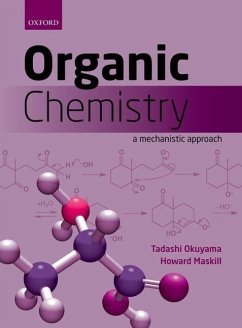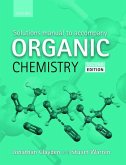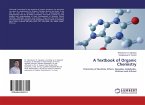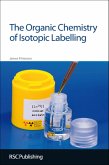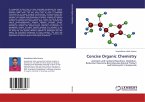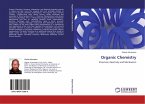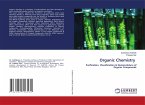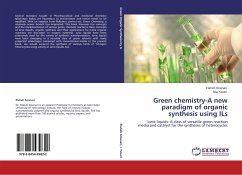- Broschiertes Buch
- Merkliste
- Auf die Merkliste
- Bewerten Bewerten
- Teilen
- Produkt teilen
- Produkterinnerung
- Produkterinnerung
Organic Chemistry: A mechanistic approach combines a focus on core topics and themes with a mechanistic approach to the explanation of the reactions it describes, making it ideal for those looking for a solid understanding of the central themes of organic chemistry.
Andere Kunden interessierten sich auch für
![Solutions Manual to accompany Organic Chemistry Solutions Manual to accompany Organic Chemistry]() Jonathan ClaydenSolutions Manual to accompany Organic Chemistry50,99 €
Jonathan ClaydenSolutions Manual to accompany Organic Chemistry50,99 €![A Textbook of Organic Chemistry A Textbook of Organic Chemistry]() Niravkumar H. SapariyaA Textbook of Organic Chemistry36,99 €
Niravkumar H. SapariyaA Textbook of Organic Chemistry36,99 €![Organic Chemistry of Isotopic Labelling Organic Chemistry of Isotopic Labelling]() James R HansonOrganic Chemistry of Isotopic Labelling71,99 €
James R HansonOrganic Chemistry of Isotopic Labelling71,99 €![Concise Organic Chemistry Concise Organic Chemistry]() Kesatebrhan Haile AsressuConcise Organic Chemistry51,99 €
Kesatebrhan Haile AsressuConcise Organic Chemistry51,99 €![Organic Chemistry Organic Chemistry]() Olajide MustaphaOrganic Chemistry38,99 €
Olajide MustaphaOrganic Chemistry38,99 €![Organic Chemistry Organic Chemistry]() Sudhakara AralihalliOrganic Chemistry36,99 €
Sudhakara AralihalliOrganic Chemistry36,99 €![Green chemistry-A new paradigm of organic synthesis using ILs Green chemistry-A new paradigm of organic synthesis using ILs]() Elaheh KowsariGreen chemistry-A new paradigm of organic synthesis using ILs38,99 €
Elaheh KowsariGreen chemistry-A new paradigm of organic synthesis using ILs38,99 €-
-
-
Organic Chemistry: A mechanistic approach combines a focus on core topics and themes with a mechanistic approach to the explanation of the reactions it describes, making it ideal for those looking for a solid understanding of the central themes of organic chemistry.
Hinweis: Dieser Artikel kann nur an eine deutsche Lieferadresse ausgeliefert werden.
Hinweis: Dieser Artikel kann nur an eine deutsche Lieferadresse ausgeliefert werden.
Produktdetails
- Produktdetails
- Verlag: Oxford University Press; Oup Oxford
- Seitenzahl: 688
- Erscheinungstermin: 7. November 2013
- Englisch
- Abmessung: 264mm x 195mm x 38mm
- Gewicht: 1275g
- ISBN-13: 9780199693276
- ISBN-10: 0199693277
- Artikelnr.: 39304203
- Herstellerkennzeichnung
- Libri GmbH
- Europaallee 1
- 36244 Bad Hersfeld
- gpsr@libri.de
- Verlag: Oxford University Press; Oup Oxford
- Seitenzahl: 688
- Erscheinungstermin: 7. November 2013
- Englisch
- Abmessung: 264mm x 195mm x 38mm
- Gewicht: 1275g
- ISBN-13: 9780199693276
- ISBN-10: 0199693277
- Artikelnr.: 39304203
- Herstellerkennzeichnung
- Libri GmbH
- Europaallee 1
- 36244 Bad Hersfeld
- gpsr@libri.de
Tadashi Okuyama is Professor Emeritus at the University of Hyogo, Japan, where his research has explored organic reaction mechanisms, acid-base catalysis, and heteroatom chemistry, and his teaching has included organic chemistry and advanced courses in physical organic chemistry. He has published a number of textbooks in Japanese, and has also translated a number of English language texts for the Japanese market. Howard Maskill is a Visiting Professor in the Department of Chemical and Biological Sciences, University of Huddersfield, UK, having retired as Senior Lecturer in 2004. His research explores the mechanism of reactions of organic compounds in solution.
* 1: Chemical bonding and molecules
* 2: Molecular structure and shapes of organic molecules
* 3: Organic compounds: their functional groups, intermolecular
interactions and physical properties
* 4: Conformation and strain in molecules
* 5: Conjugation, pi-electrion delocalization, and aromaticity
* 6: Acids and bases
* 7: Organic reactions and concept of mechanism
* 8: Nucleophilic addition to the carbonyl group in aldehydes and
ketones
* 9: Nucleophilic substitution of carboxylic acid derivatives
* 10: Reactions of carbonyl compounds with hydride donors and
organometallic reagents
* 11: Stereochemistry and molecular chirality
* 12: Nucleophilic substitution reactions of haloalkanes and related
compounds
* 13: Elimination reactions of haloalkanes and related compounds
* 14: Reactions of alcohols, ethers, thiols, sulfides, and amines
* 15: Addition reactions of alkenes and alkynes
* 16: Enolate anions and their reactions
* 17: Enolate ions, their equivalents and reactions
* 18: Reactions of nucleophiles with alkenes and aromatic compounds
* 19: Polycyclic and heterocyclic aromatic compounds
* 20: Rearrangement reactions
* 21: Pericyclic reactions: cycloadditions, electrocyclic reactions,
and sigmatropic rearrangements
* 22: Rearrangement reactions involving polar molecules and ions
* 23: Biomolecules
* 24: Chemistry of biomolecules
* 25: Structural determination of organic compounds
* 2: Molecular structure and shapes of organic molecules
* 3: Organic compounds: their functional groups, intermolecular
interactions and physical properties
* 4: Conformation and strain in molecules
* 5: Conjugation, pi-electrion delocalization, and aromaticity
* 6: Acids and bases
* 7: Organic reactions and concept of mechanism
* 8: Nucleophilic addition to the carbonyl group in aldehydes and
ketones
* 9: Nucleophilic substitution of carboxylic acid derivatives
* 10: Reactions of carbonyl compounds with hydride donors and
organometallic reagents
* 11: Stereochemistry and molecular chirality
* 12: Nucleophilic substitution reactions of haloalkanes and related
compounds
* 13: Elimination reactions of haloalkanes and related compounds
* 14: Reactions of alcohols, ethers, thiols, sulfides, and amines
* 15: Addition reactions of alkenes and alkynes
* 16: Enolate anions and their reactions
* 17: Enolate ions, their equivalents and reactions
* 18: Reactions of nucleophiles with alkenes and aromatic compounds
* 19: Polycyclic and heterocyclic aromatic compounds
* 20: Rearrangement reactions
* 21: Pericyclic reactions: cycloadditions, electrocyclic reactions,
and sigmatropic rearrangements
* 22: Rearrangement reactions involving polar molecules and ions
* 23: Biomolecules
* 24: Chemistry of biomolecules
* 25: Structural determination of organic compounds
* 1: Chemical bonding and molecules
* 2: Molecular structure and shapes of organic molecules
* 3: Organic compounds: their functional groups, intermolecular
interactions and physical properties
* 4: Conformation and strain in molecules
* 5: Conjugation, pi-electrion delocalization, and aromaticity
* 6: Acids and bases
* 7: Organic reactions and concept of mechanism
* 8: Nucleophilic addition to the carbonyl group in aldehydes and
ketones
* 9: Nucleophilic substitution of carboxylic acid derivatives
* 10: Reactions of carbonyl compounds with hydride donors and
organometallic reagents
* 11: Stereochemistry and molecular chirality
* 12: Nucleophilic substitution reactions of haloalkanes and related
compounds
* 13: Elimination reactions of haloalkanes and related compounds
* 14: Reactions of alcohols, ethers, thiols, sulfides, and amines
* 15: Addition reactions of alkenes and alkynes
* 16: Enolate anions and their reactions
* 17: Enolate ions, their equivalents and reactions
* 18: Reactions of nucleophiles with alkenes and aromatic compounds
* 19: Polycyclic and heterocyclic aromatic compounds
* 20: Rearrangement reactions
* 21: Pericyclic reactions: cycloadditions, electrocyclic reactions,
and sigmatropic rearrangements
* 22: Rearrangement reactions involving polar molecules and ions
* 23: Biomolecules
* 24: Chemistry of biomolecules
* 25: Structural determination of organic compounds
* 2: Molecular structure and shapes of organic molecules
* 3: Organic compounds: their functional groups, intermolecular
interactions and physical properties
* 4: Conformation and strain in molecules
* 5: Conjugation, pi-electrion delocalization, and aromaticity
* 6: Acids and bases
* 7: Organic reactions and concept of mechanism
* 8: Nucleophilic addition to the carbonyl group in aldehydes and
ketones
* 9: Nucleophilic substitution of carboxylic acid derivatives
* 10: Reactions of carbonyl compounds with hydride donors and
organometallic reagents
* 11: Stereochemistry and molecular chirality
* 12: Nucleophilic substitution reactions of haloalkanes and related
compounds
* 13: Elimination reactions of haloalkanes and related compounds
* 14: Reactions of alcohols, ethers, thiols, sulfides, and amines
* 15: Addition reactions of alkenes and alkynes
* 16: Enolate anions and their reactions
* 17: Enolate ions, their equivalents and reactions
* 18: Reactions of nucleophiles with alkenes and aromatic compounds
* 19: Polycyclic and heterocyclic aromatic compounds
* 20: Rearrangement reactions
* 21: Pericyclic reactions: cycloadditions, electrocyclic reactions,
and sigmatropic rearrangements
* 22: Rearrangement reactions involving polar molecules and ions
* 23: Biomolecules
* 24: Chemistry of biomolecules
* 25: Structural determination of organic compounds

